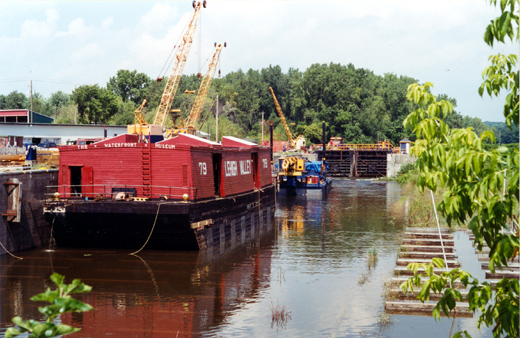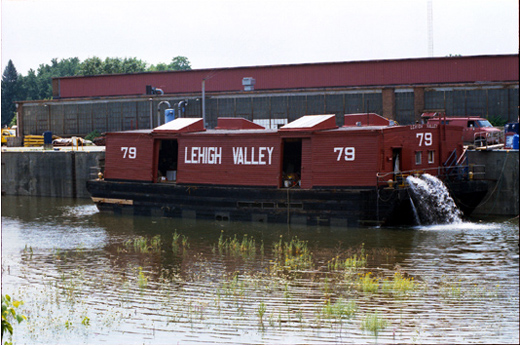All was going well till the week of August 16th. We needed to move the barge about 7 feet to work upon the planks upon which the barge rested on. Each of the seven ways had two old planks which met new planking on either side. The lack of any substantial leaking on the trip to drydock had given me confidence in the state of the old calking. The new planking was tight with newly calked seams. I did not seek the advice of anyone. None of the crew seemed too concerned about the task ahead. At 8 AM the gate valves were opened and water poured into the docks. What ensued unfortunately could have been avoided. I had planned poorly and was not prepared for the amount of water that entered the barge.
Water rose in the bilges. Floorboards below began to float. The gate valves for the drydock were closed and the wicket was opened to drain the drydock but not before water reached 4 feet in the bilges. Files, carpets, boilers, etc got flooded. One crew member was injured but returned to work after 2 weeks.
Master Shipwright David Short of North Atlantic Shipbuilding and Repair and Barge Captain David Sharps convened and more pumps were rounded up to try again the same day. David Sharps would not be available for the following week since he was contracted to perform in the show "PICTURE RED HOOK" back in Brooklyn. Tony Ferris, Canal Section Superintendent arranged for a huge 4 NY State Canal Corporation Pump to be used. Using better communication and caution, the water was brought back into the drydock to the bottom of the ways and slowly raised. The procedure looked like a salvage operation. Three 3 gas pumps, One 2 gas pump, Two 2 electric pumps were hardly keeping ahead of the water spilling into the barge by way of the dried out seams of the old planking and the substantial gaps where the new planks met the old planks. The 4 electric pump put into service by the NY State Canal Corporation made all the difference. The barge floated with water spurting out of the barges pumps in all directions. The barge was led seven feet astern and settled nicely down upon her marks. 14 oak shores were erected to keep the bow and stern from settling any further since each end now had about a 4 overhang plus the additional 4 of the deck
The text on these three pages was provided by David Sharps President of the The Waterfront Museum and Showboat Barge





| ©2003 Chris Queeney Photography |
| contact: chris@seafoto.com |